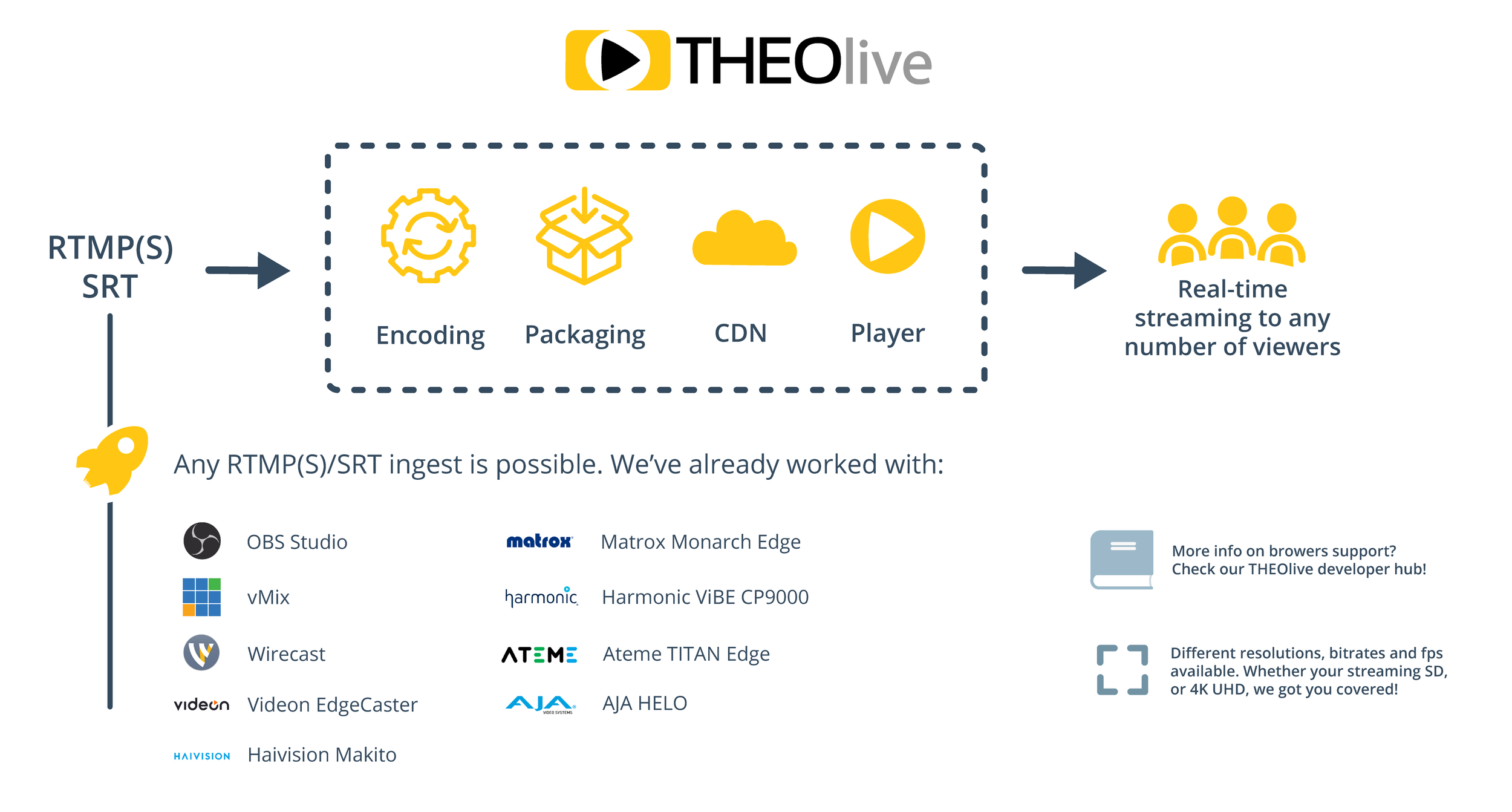THEOlive: embedding high-quality real-time video at scale in your applications
How THEOlive leverages HESP to make it easy for providers of sports betting, iGaming and interactive entertainment to stream real-time to any audience size.
HESP Alliance blog by THEO Technologies - February 2022
There has been a drastic shift in the way we consume online content and, as we all witnessed, this change accelerated during the last years. Demand for interactive experiences is increasing and will continue to increase as the viewer needs and behavior shifts. These days you can access online slot games and tables from anywhere in the world, join a live auction or an interactive online event. Following the return to physical events, companies still continue hosting virtual events. A Statista survey projected that 40 percent of the marketing events would be virtual in 2022, an increase of 5% compared to 2020. When looking at growth of other interactive online experiences, we see in-game sports betting is anticipated to grow significantly, as 36 U.S. states have legalized sports gambling since 2018.
The shift towards more interactive streaming experiences accentuates the increasing viewer's expectations. Today the primary complaint with watching live events online is the delay of high-quality video streams. The viewer frustration aside, the streaming latency is an inhibitor to making online video a more engaging and interactive experience, which brings us to the general requirement for real-time streaming: high quality sub-second latency at scale while reaching hundreds, thousands or even millions of viewers.
THE CHALLENGE OF LOW LATENCY LIVE STREAMING
Low latency live streaming is typically seen as a challenge due to the trade-off between desired low latency and scalability. Do we always need to sacrifice latency for scalability or vice versa? Solutions leveraging HTTP-based protocols such as LL-HLS and LL-DASH are very scalable to any audience size. While suited well to deliver streams at a broadcast-like latency around 3 to 8 seconds, these do not provide for sub-second latency. On the other hand, solutions using WebRTC as underlying technology bring real-time streaming, but are complex and expensive to scale as each client requires a persistent connection with the backend, and scaling takes place by spinning up additional server infrastructure instead of using a standard CDN.
AN EASY AND AFFORDABLE PATH TO REAL-TIME STREAMING AT SCALE
This is where THEOlive emerges as an essential solution for real-time streaming at scale. THEOlive is an end-to-end cloud-based video API, which leverages the High Efficiency Streaming Protocol (HESP) and covers the full pipeline from video ingest and distribution over a global CDN, to high-quality video playback and extensive scaling. THEOlive is designed to make real-time streaming at scale easy. It’s an API-first solution, which brings the video infrastructure of large media companies to any developer, so that they can easily embed high-quality real-time video to any audience size in their applications.
Figure 1: THEOlive is an end-to-end cloud-based solution for real-time streaming at scale
It’s by leveraging the High Efficiency Streaming Protocol, which is an HTTP-based streaming protocol, that THEOlive is able to easily and cost-efficiently scale to any number of viewers over a global CDN. HESP also helps THEOlive achieve its sub-second latency by combining two streams: an initialization stream and a continuation stream. Leveraging chunked transfer encoding with byte-range requests, it is possible to very quickly start a stream or to change qualities upon changing network conditions. As a result, lower player buffers are needed to bring the same viewer quality of experience, and hence lower latencies can be achieved. The entire THEOlive workflow, from encoder, to HESP packager, CDN and HESP player has been optimized for sub-second latency.
HOW DOES THEOlive WORK?
Getting started with THEOlive is straightforward and can be completed in a few simple steps. through the management console, or through API:
Sign up: Request access to the THEOlive management console.
Create your channel: Once you have access to the management console, you can create your first channel by clicking "create channel". Here you can select an ingest location and enter a name for the channel. There are also a few advanced settings to define whether or not to use ABR, select a value for FPS and choose the right resolution. When ABR is selected, THEOlive will automatically generate a bitrate ladder to optimally serve viewers with various network conditions.
Configure your ingest: After creating your first channel, you will be directed towards the details page of your newly created channel. Here you can find details to configure your ingest. You can ingest any RTMP/SRT. The THEO team has already worked with an extensive set of encoders to ingest into THEOlive e.g. OBS Studio, Videon Edgecaster, Wirecast, Vmix, Haivision Makito, Matrox Monarch Edge, Harmonic ViBE CP9000, Ateme Titan Edge and AJA HELO encoders.
Embed the player in your webpage: The next step is including the THEOlive channel on your page by using the embed script and the channel ID. In this step, you can also customize your player. Some of the things you can easily change to adapt the look and feel are the colors of your player, adding a logo, poster image or announcement message and enabling/disabling auto-play. There are more customization options available through a self-hosted player. In reality, this step can be boiled down to a simple copy-paste of the embed code, which is generated.
Define security settings: Before starting your channel, it’s possible to configure different levels of security. A first option is geoblocking, to limit which countries can access your real-time stream. You can also use token security to determine if content can be shared with the end user. Lastly, it’s even possible to enable studio-approved DRM for your channels!
Figure 2: Easily set up and configure a THEOlive channel through the management console or API
That’s it! You can start streaming by following these five simple steps. As THEOlive is API-first, each of the above steps can also be completed via API calls, which are documented in the API reference.
High-quality real-time streaming at scale is key in bringing interactive viewer experiences for use cases such as sports betting, iGaming and interactive entertainment. Solutions like THEOlive make it easy and affordable for live streaming services to get started and to stream real-time to any audience size. They also bring innovation through leveraging HESP as a technology. HESP not only enables high-quality real-time streaming at scale, but also makes it possible to leverage studio-approved DRM with real-time streaming, something which today is typically seen as a challenge by many providers.
ABOUT THEO TECHNOLOGIES
THEO Technologies empowers the world’s leading media and entertainment companies to deliver cutting-edge video services, efficiently and on any device. Their flagship product THEOplayer provides premium video playback experiences to leading media & entertainment companies. THEO is the inventor of HESP and founding member of the HESP Alliance. In 2022 they launched THEOlive, to deliver high-quality real-time video at scale to providers of live sports betting, iGaming and interactive entertainment.


